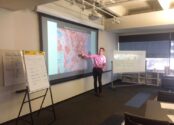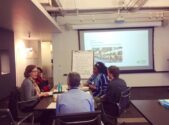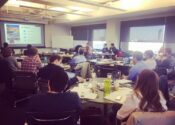
On April 26th, ITDP hosted a workshop in Dallas to aid coalitions of people in the city in setting a vision for shifting away from single occupancy vehicle use and towards the support of walking, cycling, and public transit. This workshop was held at a pivotal moment for Dallas. With a newly formed Department of Transportation (DOT), the city is in the midst of developing a comprehensive mobility plan. While the city has been in the habit of making forecasts based on existing trends, setting measurable long-term mode share targets that will require alignment with public budgets will be the key to the plan’s success.
The workshop focused on an assessment of mobility indicators such as people near transit, access to jobs, and low income people near frequent transit. Attendees to the workshop included representatives from the Dallas City Hall, the North Central Texas Council of Governments (NCTCOG), Regional Chamber of Commerce, Dallas Area Rapid Transit (DART), as well other local private sector, non-profit, academic, and advocacy organizations.
The population of the Dallas-Fort Worth-Arlington Metroplex grew by 146,238 in 2017 – the most growth of any metro area in the U.S. – making it the fourth most populous metro area in the country. The city of Dallas alone grew by 10%. Dallas must decide how it will accommodate this growth without adding traffic congestion. The key, of course is to improve access to the city, while reducing dependency on private cars, with a substantial mode shift to transit.
The current mode shares for the City of Dallas and the metro region leave much room for improvement:
| Mode | City | Region |
| Driving Alone | 76% | 80% |
| Carpool | 11% | 10% |
| Public Transit | 4% | 2% |
| Walk | 2% | 1% |
| Bike | 0.2% | 0.1% |
Source: U.S. Census Bureau (ACS 2016 Report)
ITDP made the case to Dallas in many ways. By mapping jobs near frequent transit, (defined as transit with headways of 12 minutes or less), it becomes clear where there is great potential for transit-oriented development. Dallas has 90 miles of light rail in a hub and spoke pattern branching out from the Downtown. The setting of sustainable mobility targets may be the first step for Dallas toward achieving the greater goal of reducing single occupancy vehicle use and shifting toward sustainable transport.
Long-term mode share targets from other U.S. cities were presented to illustrate that many peer cities have embarked on this process with the intention of decreasing single occupancy vehicle use. These cities have already begun to see the results of investing in quality walking and cycling facilities, and offering frequent transit services to move closer toward achieving their mobility goals. ITDP compared Dallas to these peers cities on a host of indicators, such as the percentage of jobs near frequent transit with first/last mile connections made by walking and cycling. Dallas performs among the worst on the list, even compared to other sunbelt cities such as Houston, Atlanta, Albuquerque and Denver.
Getting to the Targets
A major component of the workshop included an interactive exercise that challenged participants to produce a collective vision for future mobility in Dallas. Participants were arranged into groups based on transport mode, and each group developed targets. These are the results:


Public Transit
- Increase people living near frequent transit to 10% by 2028
- Increase access to jobs by public transit to 50% by 2030
Cycling
- Increase cycling mode share from 0.2% to 0.8% by 2022
- Increase the number of children biking to school by 20% by 2030
Participants also outlined the policies that would be needed to reach these targets by the proposed dates. Policy changes included a desire to reduce resident speed limits to 25 mph and to make zoning changes that would cluster more people within a ½ mile of a buffered bike lane among many others. The goal of the exercise was to have the group work as a unified coalition around each transport mode. Each group developed an action plan for how they would realize all the steps needed to reach the targets.
With a growing workforce and emphasis on strengthening the urban core, Dallas has significant opportunity to apply some of the lessons learned from their peer cities and reinvent themselves as a transit oriented city with walkable urbanism and world-class cycling infrastructure.





